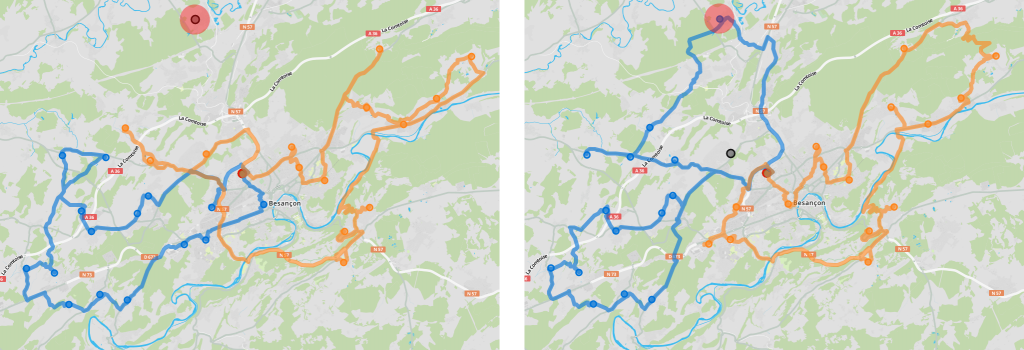Verso’s API for route optimization is constantly being updated to respond more fully to our users’ needs. The October 2019 update introduces functionalities designed to fine-tune approaches to problem solving and to allow us to solve new kinds of problems as well. This update uses the 1.5 version of VROOM, which is the open-source software we have developed for optimizing itineraries.
Managing Priorities

When a company is faced with limited load capacities or a limited number of available vehicles or man-hours of work, it is sometimes difficult to get everything done. In the example illustrated above, the job that gets left out is not surprisingly the one located furthest away (left). But what if that job had priority? It is now possible to include priorities in problem solving and ensure that the most important jobs appear in the solution (right).
Combining Deliveries and Pickups
Until now, it was easy enough for us to model simple logistical problems, such as when a vehicle leaves a warehouse with loads to be delivered to various places or when it leaves empty and returns after a round of pickups. But out in the field companies usually deal with a more complicated mix of deliveries and pickups, sometimes at the same location. That makes it far more difficult than it might seem to guarantee that solutions take into account actual load capacities, which depend on the pickups already made, the deliveries yet to be made, and the order in which these operations are carried out.
That functionality has now been implemented. We are now able to work with a mix of pickups and deliveries and ensure that we take into account a vehicle’s actual load capacity at any given point.
Enhanced Performance
To be sure, the introduction of these functionalities involves more complex problem solving, but the icing on the cake is that it has not increased the time needed to generate solutions. In fact, that time has actually decreased both because of various efficiency mechanisms built into the new code and because, while the verification tests needed when dealing with combinations of deliveries and pickups are more complex, there is far less need to have recourse to them. The conventional VRPTW benchmarksshow an average decline in calculation time of nearly 40%.
To learn more, check out the on-line documentation for our API and contact us to see how your business can benefit from these new functionalities.
